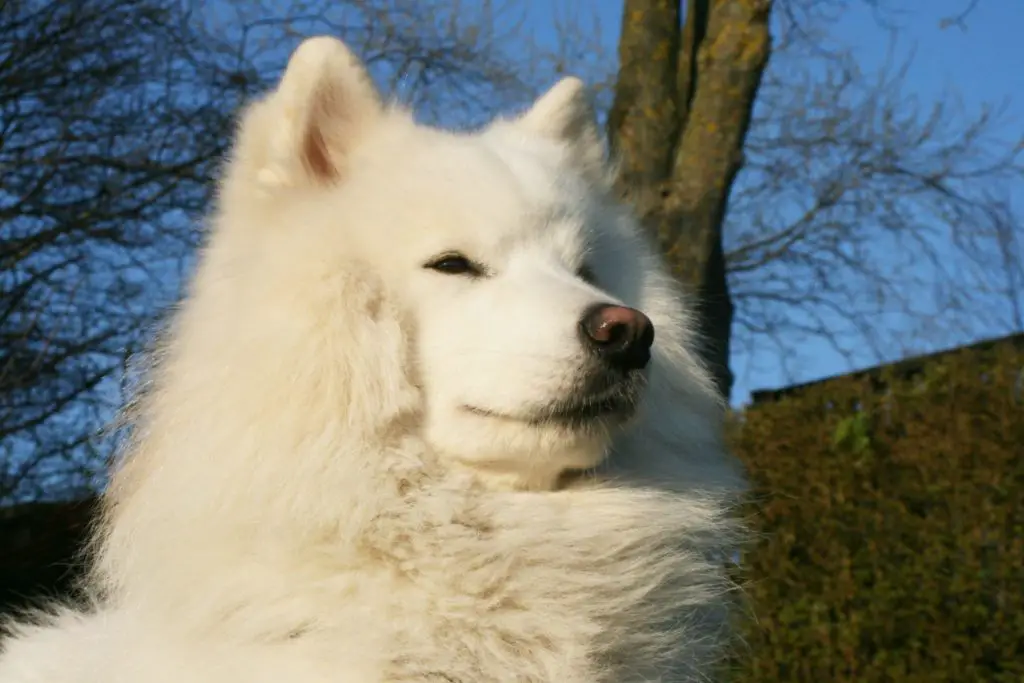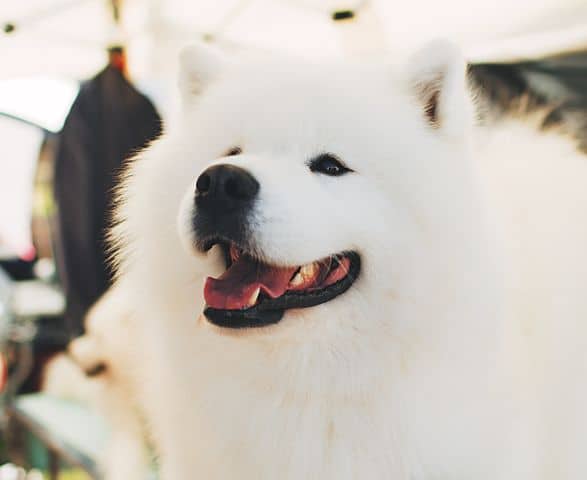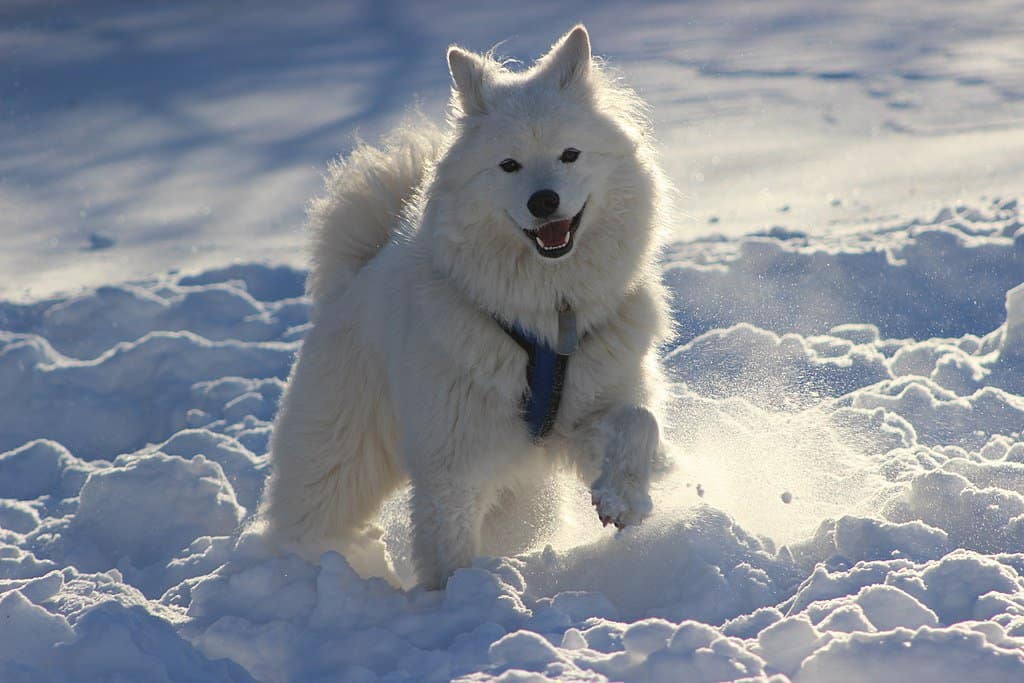If you’ve ever owned a dog, you’ve likely experienced some shedding. Unless your dog is hairless, this is a normal part of dog ownership. However, you may find yourself wondering if your dog’s shedding is normal and, if so, how to manage it.
Whether you just brought your first Samoyed puppy home or you are an experienced Samoyed owner, it is never too late to learn more about their care. Whatever stage of pet ownership you are at, it is important to learn the ins and outs of coat maintenance and shedding. Just like with human hair, changes or abnormalities can be a sign of health issues. This is why it is so important to understand what is a normal amount of shedding from your pup.
A common misconception about shedding is that dogs with long fur shed less than those with short fur. However, this is not necessarily true. Dogs with longer fur may have more noticeable shedding due to the length of the hair they lose, but plenty of shorter-haired breeds lose just as much hair. Shedding has much more to do with the breed of dog than it does with how long their fur is.
Samoyeds are known as heavy shedders. Since their coats are so long, it is also difficult to see their skin, which makes it even more important to know what to expect from their shedding. Looking at their big, fluffy coat can seem daunting at first, but understanding how to manage their shedding is really quite straightforward.
This article will help teach you why Samoyeds shed, when to be concerned about their shedding, and how to manage it.

Why Do Samoyeds Shed?
To answer this question, it is first important to know why dogs shed in general. Shedding is absolutely normal amongst healthy dogs. Dogs shed to get rid of old and damaged fur. Puppies will get what is known as a “puppy coat” that they will shed entirely between 4 to 6 months before their adult coat comes in. If you see your puppy shedding a lot of fur, this is likely what is taking place.
Some dogs will grow thicker coats in the fall/early winter when it is cold. This is particularly true of dogs who are double-coated. This thicker coat helps them to insulate their bodies and stay warm. During the spring/early summer, they will shed these coats away. This seasonal shedding is often known as “blowing coat.”
This information can give us some insight into why Samoyeds shed, but it isn’t the whole picture. Samoyeds originated in Russia, and they do have thick, double-coated fur. This thick coat helped them to survive in extremely cold conditions. They are known to be heavy seasonal shedders. However, the amount of shedding they experience will vary by the area you live in. In areas where it is hot, owners should be prepared for excessive shedding during the spring. However, in more moderate areas, you can expect to see a bit less hair loss in your Samoyed. If you live in a particularly cold area, you may even see little to no seasonal shedding!
Along with losing their winter coat in the spring, you should expect your Samoyed to experience another lighter coat blow in the fall. Before their winter coat grows in, they will shed out their lighter summer coat. Because the Samoyed’s coat is thinner in the summer, their shedding may be more manageable in the fall. However, some owners report comparable shedding in the spring and fall, so it is important to be prepared for any outcome.
Along with this seasonal shedding, Samoyeds are a breed that sheds all year. During the portions of the year that they aren’t blowing their coat, they should be moderate shedders. If you own a Samoyed, get used to using lint rollers or wearing all white so that the hairs are less noticeable!
When Should I Worry About Shedding?

Most of the time, your Samoyed’s shedding is perfectly normal. However, we recommend you try to keep a mental note of how much your dog typically sheds. Any major changes could be a sign of a problem. If you notice that your Samoyed is shedding excessively (compared to normal), there are a few health issues to be worried about.
First, poor nutrition can lead to excessive shedding. This is the most common reason for excessive shedding in dogs. Thankfully, it can normally be fixed with some simple dietary changes. If you recently changed your dog’s food and notice that they have begun losing a lot more hair than usual, that very well could be the cause. Additionally, as dogs get older, their nutritional needs may change. If you notice any changes with your Samoyed’s shedding, you should consult with their vet to ensure their nutritional needs are being met
Another more serious cause of excessive shedding or fur loss is parasites and fungi. If you can see fleas, ticks, or mites on your dog, this would explain their excessive shedding. However, since Samoyeds have such long coats, you may notice changes to their fur before you can see the parasites on them.
Parasites will typically cause fur loss around the stomach, ears, and eyes. On the other hand, a common fungus that causes fur loss is ringworm. If you notice circular areas of hair loss on your dog, this could be the first indication of ringworm. Thankfully, these fungi and parasites are all very easily treatable under veterinary care.
Finally, shedding in Samoyeds can be caused by allergies. Just like with humans, some dogs have things that just don’t agree with them. This could be something like food, medicine, or pollen. All of these things (and many others) can cause skin and fur issues for your Samoyed. If you can’t pinpoint what is causing your dog discomfort, taking them to an allergist or dermatologist may be helpful.
As with all health issues, if you notice changes in your dog please speak to your vet as soon as possible. Excessive shedding can be caused by a whole host of other conditions such as pregnancy, cancer, or anxiety. However, nutrition, parasites, and allergies are by far the most common causes to be aware of.
How to Prevent Samoyed Shedding
Since Samoyeds shed heavily, keeping up with their fur can be a problem for owners who are unprepared. However, with a few tips and tricks, you’ll be able to minimize the amount of fur in your house.
By far the easiest way to minimize Samoyed shedding is to get into a schedule of brushing them. Ideally, you should brush them every day. However, you should brush them at least three times a week. Not only will this reduce the amount of hair they deposit around the house, but it is also a great way to bond with your dog. Also, most Samoyeds love the feeling of being brushed, so it is great for you and your pup!
Because Samoyeds are double-coated, a regular dog brush may not be the best option. You may need to experiment with different tools, but typically a de-shedding tool will help you to get to the Samoyed’s undercoat. This is important to prevent your dog’s coat from matting and becoming painful for them.
Some people may suggest that you bathe your Samoyed more often, but we advise against this. Samoyeds have fur that is dirt-resistant and waterproof. They are built to not need to be bathed often. Doing so too frequently can actually dry out their skin and cause more issues with their fur.
Additionally, failing to dry them properly can cause their skin to get infected, which only adds to the issue you are trying to prevent. Because they have so much fur, this can present a huge issue for owners who are not properly equipped to dry them off.
To combat these bathing issues, we suggest taking your Samoyed to the groomer for their baths. The Samoyed Club of America suggests bathing them “at least twice a year for his health and comfort.” Of course, you can bathe your them more than that if you’d like, but we suggest always having a professional perform their baths.
Another way you can prevent Samoyed fur from building up in your home is to change your air filter regularly. Changing your filter every two months should help to keep some of the dog fur and odor from lingering in your house. However, along with monitoring the frequency you change your filter at, it is important to use the correct type of air filter.
Each air filter has what is called a MERV value. This indicates what size particles the filter can capture (with higher MERV numbers capturing smaller particles). MERV values of 9 to 12 are able to capture pet dander and fur. Having this type of filter in your home will collect more of your Samoyed’s fur. Also, this should help to alleviate allergies for anyone who may be allergic to dogs in the home.
Are Samoyeds Hypoallergenic?

It might sound strange that a dog that sheds as much as the Samoyed is considered hypoallergenic, but it’s true! The reason why they’re considered hypoallergenic even though they shed so much is that dog hair is not actually what causes allergies.
You see, the real source of allergic reactions is often not the fur, but the exposure to certain proteins in your dog’s saliva, urine, or flakes of skin. Since the Samoyed produces less of these they’re often considered hypoallergenic.
However, no dog is considered 100% hypoallergenic, and while Samoyeds are partially hypoallergenic they’re not as hypoallergenic as some other breeds such as the Poodle.
If you plan on getting a dog and suffer from allergies it’s always a good idea to get some exposure to the dog first to see how your allergies react.
How to Clean Samoyed Shedding
No matter how many preventative steps you take, it is inevitable that your Samoyed will shed in your home. This can be quite frustrating, especially when you want to host guests. However, as your Samoyed’s fur grows, this shedding process helps to keep them healthy. Thankfully, there are a few things you can do to remove hair from your house.
First, it is much easier to keep blankets clean than it is to clean your furniture. One way to easily keep your home free of your Samoyed’s fur is to invest in lots of washable blankets. These can be easily removed and thrown in the washing machine.
Having the right cleaning supplies can also help you to overcome pet fur in your house. The best tool for the owner of a Samoyed to have is a vacuum that is built for picking up pet fur. These often come with hand attachments that can be used on furniture. There are some models which also are designed for use on wood, carpet, and tile. However, for things like tile and wood, a simple broom should do if you’re in a pinch.
Additionally, Robot vacuums are a great way to keep excessive dog hair in check. The Robot vacuum can run non-stop and get rid of most of the hair around your home.
Final words
Like any other dog, Samoyeds will shed. However, due to their type of coat, Samoyeds may lose more hair than other dogs. Thankfully, the worst of their shedding should only occur during spring when they blow their winter coat. This is especially true for Samoyeds living in very hot climates. If you aren’t prepared for a dog that sheds, the Samoyed may not be the right fit for you.
However, if you do decide that you’d like to bring a Samoyed into your home, you can use the tips listed above to minimize shedding in your home and to help capture any fur going through your HVAC system. Samoyeds are already known for being hypoallergenic, but these tips should make living with them even more tolerable for people with allergies.
If you have any concerns about your Samoyed’s health or the state of their coat, please see your vet. They can help you to determine whether their shedding is normal or, if not, what is causing them to excessively shed.
We hope this guide has helped you to better understand what type of shedding to expect from your Samoyed!
If you love Samoyeds but want a dog that sheds less, you might be interested in checking out some Samoyed Mixes. Some of these mixed breeds shed a lot less!
- How Long Do American Eskimo Dogs Live? Important Factors and Care Tips - September 29, 2023
- Do American Bulldogs Need Grooming? Essential Tips and Care Guidelines - September 29, 2023
- Do Bengal Cats Enjoy Playing? Essential Tips for Keeping Them Active - September 29, 2023